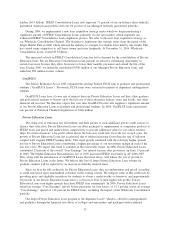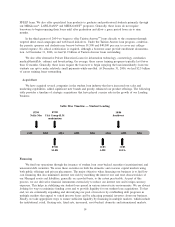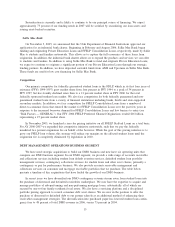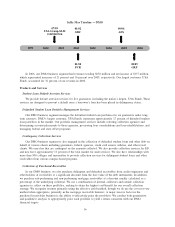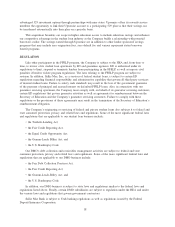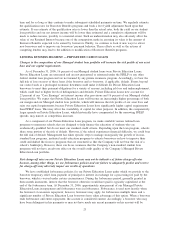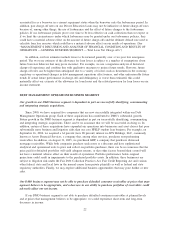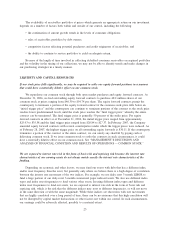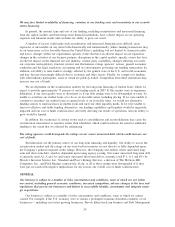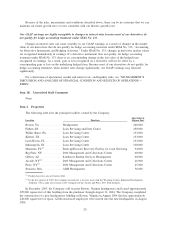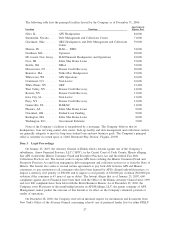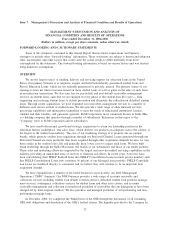Sallie Mae 2006 Annual Report Download - page 23
Download and view the complete annual report
Please find page 23 of the 2006 Sallie Mae annual report below. You can navigate through the pages in the report by either clicking on the pages listed below, or by using the keyword search tool below to find specific information within the annual report.accounted for as a borrower in a current repayment status when the borrower exits the forbearance period. In
addition, past charge-off rates on our Private Education Loans may not be indicative of future charge-off rates
because of, among other things, the use of forbearance and the effect of future changes to the forbearance
policies. If our forbearance policies prove over time to be less effective on cash collections than we expect or
if we limit the circumstances under which forbearance may be granted under our forbearance policies, they
could have a material adverse effect on the amount of future charge-offs and the ultimate default rate used to
calculate loan loss reserves which could have a material adverse effect on our results of operations. (See
“MANAGEMENT’S DISCUSSION AND ANALYSIS OF FINANCIAL CONDITION AND RESULTS OF
OPERATIONS — LENDING BUSINESS SEGMENT — Total Loan Net Charge-offs.”)
In addition, our loss estimates include losses to be incurred generally over a two-year loss emergence
period. The two-year estimate of the allowance for loan losses is subject to a number of assumptions about
future borrower behavior that may prove incorrect. For example, we use a migration analysis of historical
charge-off experience and combine that with qualitative measures to project future trends. However, future
charge-off rates can be higher than anticipated due to a variety of factors such as downturns in the economy,
regulatory or operational changes in debt management operations effectiveness, and other unforeseeable future
trends. If actual future performance in charge-offs and delinquency is worse than estimated, this could
materially affect our estimate of the allowance for loan losses and the related provision for loan losses on our
income statement.
DEBT MANAGEMENT OPERATIONS BUSINESS SEGMENT
Our growth in our DMO business segment is dependent in part on successfully identifying, consummating
and integrating strategic acquisitions.
Since 2000, we have acquired five companies that are now successfully integrated within our Debt
Management Operations group. Each of these acquisitions has contributed to DMO’s substantial growth.
Future growth in the DMO business segment is dependent in part on successfully identifying, consummating
and integrating strategic acquisitions. There can be no assurance that we will be successful in doing so. In
addition, certain of these acquisitions have expanded our operations into businesses and asset classes that pose
substantially more business and litigation risks than our core FFELP student loan business. For example, on
September 16, 2004, we acquired a 64 percent (now 88 percent) interest in AFS Holdings, LLC, commonly
known as Arrow Financial Services, a company that, among other services, purchases non-performing
receivables. In addition, on August 31, 2005, we purchased GRP, a company that purchases distressed
mortgage receivables. While both companies purchase such assets at a discount and have sophisticated
analytical and operational tools to price and collect on portfolio purchases, there can be no assurance that the
price paid for defaulted portfolios will yield adequate returns, or that other factors beyond their control will
not have a material adverse affect on their results of operations. Portfolio performance below original
projections could result in impairments to the purchased portfolio assets. In addition, these businesses are
subject to litigation risk under the Fair Debt Collection Practices Act, Fair Credit Reporting Act and various
other federal, state and local laws in the normal course from private plaintiffs as well as federal and state
regulatory authorities. Finally, we may explore additional business opportunities that may pose further or new
risks.
Our DMO business segment may not be able to purchase defaulted consumer receivables at prices that man-
agement believes to be appropriate, and a decrease in our ability to purchase portfolios of receivables could
adversely affect our net income.
If our DMO business segment is not able to purchase defaulted consumer receivables at planned levels
and at prices that management believes to be appropriate, we could experience short-term and long-term
decreases in income.
22



